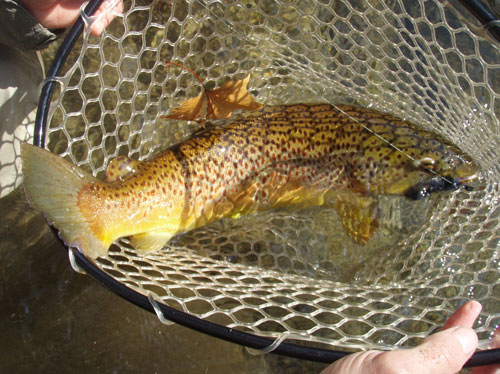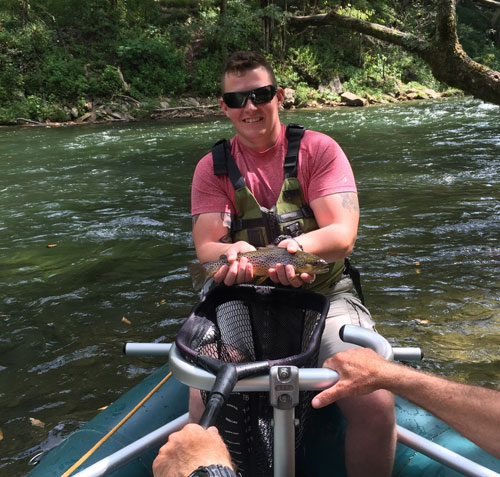I recently had someone come into the shop and comment on a picture of a large trout one of my guests had caught. His comment was that, “any fish that is handled will die in less than a month”. Being a fishing guide, I see certain fish each year that have been previously caught and released. Brown Trout have individual markings that are just like fingerprints. There have been several times over the years, that I have had different people catch the same fish. Nevertheless, his comment gave me the idea for this piece.
There are so many skills in fly fishing that an angler has to learn, in order to be successful on the water. Casting, fly identification, water reading, the list can go on and on. One of the overlooked and most important skills for anglers to learn, is proper fish handling, and fish releasing. It provides a way for anglers to return fish to the stream, unharmed. Even if you are keeping some fish for dinner, it is still important as it allows the angler a way to return larger fish back to the stream, where their genes can continue to produce quality offspring.

First and foremost, if you are planning to release fish, debarb your hook. It amazes me that this is not a requirement for fishing delayed harvest streams. Many anglers think this will make it harder to catch fish. In some ways, it usually makes it easier, as you get a better hook set on the fish. It also makes it easier to release the fish without touching it if possible. A good rule of thumb is that it is always better, if possible, to release fish without removing them from the water. This can easily be done with a pair of forceps while the trout is still in the net, without touching it with your hands. If you have to touch the fish, make sure to get your hands wet. Handling a fish with dry hands is basically a death sentence for the fish, no matter how good your intentions might be. If I use a net, I try to use one that has more of a plastic-type of material. Cloth style nets will ofttimes rub the slime off of the fish’s body. This body slime is what protects the fish from bacterial diseases. I will also get the entire net well soaked, before netting the fish.
If you have to handle the trout, handle the fish with care. If you have to take time to set up a photo, leave the fish in the water. One trick that works well is to always try to hold the net under the fish when someone is holding it for a picture. That way, if the fish does decide to do a “flip,” it will land softly into the net rather than bouncing off the floor of the boat, or the ground. Another trick I like to use is holding my breath for the duration that the fish is out of the water. This gives me a ballpark idea of how long the fish has been without its source of oxygen and makes me more aware of getting it back into its environment as soon as possible. It is important to handle the fish carefully, do not squeeze it while holding it and be gentle when releasing it. More times than not, it is necessary to revive the fish by holding it in the water, allowing water to pass by its gills. Many times, I will put the fish back in the net and move to a place where the current is not so strong, and revive and release the fish there. Hold the fish gently and wait for it to swim out of your hands. I have taken up to 15 minutes or more to revive large trout. Many times these fish will swim a ways, and then rest. I always try to watch until I know for sure they will be okay. I am always appalled to see anglers just rip the hook out of a fish’s mouth and unceremoniously, toss it back in the river. Many of those fish do not make it back alive. Remember, these fish are just as much in shock as you would be if you had just been in a car accident and gotten hurt. They feel the same way as someone who has just run a marathon. A lot depends on how long it took to get the fish to the net, and the temperature of the water. A little TLC goes a long way to making sure that the fish you just took a picture of survives to fight another day!
Ken Kastorff is the Owner of Endless River Adventures. To book a guided trip near the Nantahala Gorge or the Cheoah River, give him a call, 828-488-6199.
